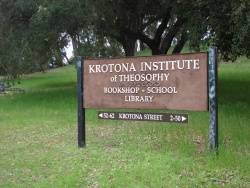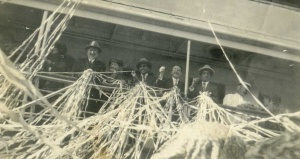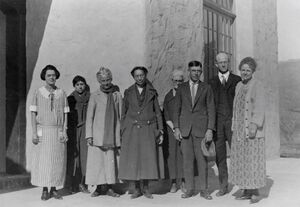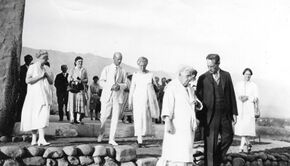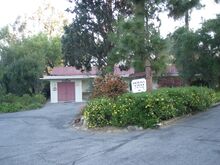Krotona Institute of Theosophy
The Krotona Institute of Theosophy is the headquarters of the Esoteric School of Theosophy, also called the Esoteric Section, E.S. or E.S.T., for the United States and Canada. It is a residential spiritual community with a school, library, and bookshop intended to serve members of the Esoteric School and the Theosophical Society, as well as the general public. The name Krotona was derived from the Crotona school of Pythagoras. The website is at https://www.krotonainstitute.org/.
History
President A. P. Warrington of the American Theosophical Society (now Theosophical Society in America) and his associates founded a spiritual center in Hollywood, California in 1912. He moved Society headquarters and book publishing from Chicago. Buildings sprang up on the new Krotona campus, to the great interest of local newspapers[1], who often referred to it as the Krotona Colony. As the film industry grew and Hollywood boomed, Krotona's location site became less serene and more expensive to operate. The American Theosophical Society's headquarters and publishing operations moved to a more central location in Chicago in 1920, under the guidance of new President L. W. Rogers. That left the American E.S. headquarters in Hollywood, along with the Order of the Star in the East and the Order of the Temple of the Rosy Cross.
See Krotona in Hollywood for more information about the Hollywood years of the Krotona Institute, from 1912-1924.
Locating in Ojai
In 1922, Mr. Warrington traveled with Jiddu Krishnamurti, his brother Jiddu Nityananda, Fritz Kunz and Marie Poutz from Australia to the United States. Krishnamurti and Nitya planned to continue by train and ship to Switzerland where a doctor would try to cure Nitya of his tuberculosis. Warrington suggested a side trip to Ojai, California:
They traveled by train to Ventura and by automobile to Ojai, arriving on July 6. Warrington had arranged for them to share a rustic cottage amid the pine trees of the East End. They loved it, so much so that Besant arranged to buy the Pine Cottage for them, along with a nearby ranch house. (The brothers dubbed it Arya Vihara, Sanskrit for “Noble House.”) Alas, Nitya found no cure in Ojai; he would succumb to his disease within three years. But Krishnamurti would maintain a home here for the rest of his very long life.
With the future World Teacher now established in Ojai, Warrington decided that this was just the place for Krotona, too. In 1924 he moved the institute from Hollywood to a 118-acre ranch property atop a hill just south of Meiners Oaks. That set the stage for Besant herself, who came to Ojai in October 1926.
Happy Valley remained undeveloped until the 1970s, but the Happy Valley Foundation never gave up on Besant’s vision. Today this property is host to the Besant Hill School of Happy Valley, the Beatrice Wood Center For the Arts, and the Ojai Foundation.[2]
Mr. Warrington had heard of Ojai through Theosophists Mary Gray, founder of the School of the Open Gate, and Robert Walton of the Liberal Catholic Church in Hollywood. Both had built homes in Ojai, and actively lobbied for a move of Krotona from Hollywood to Ojai. Warrington purchased the 118-acre Kerfoot Ranch that is now called Krotona Hill. After some months he received permission from Annie Besant to move the E.S. center to the new location.
Early days in Ojai
George H. Hall was the general manager of Krotona in Ojai, as in Hollywood since 1920, and he asked Eugene Munson to be the superintendent on site from the earliest days of development in Ojai. The Munsons moved into the Kerfoot ranch house at first. In 1924 efforts focused on construction of the E.S. administration building, the library, several cottages, and infrastructure of roads, water tower, and garages. By the end of that year, the Munsons, Halls, and Marie Poutz had moved in. Mr. Warrington was in a sanatorium, recovering from illness. The following year, more roadways were made and landscaping began. More cottages were built, and Krotona Hall.
The photo at right shows early staff members Sarah Mayes, Mathilde Saizan, Maude Kimball, Marie Poutz, Mary Goldy, Billy Mayes, Eugene Munson, and Mattie Munson.
Annie Besant's first visit
In October, 1926, Annie Besant visited Krotona for the first time. As Outer Head of the Esoteric Section, she had approved the move of Krotona Institute of Theosophy to Ojai, based primarily on the recommendation of Mr. Warrington. Complications of her political activities, legal matters, and her work as president of the international Theosophical Society had kept her from an earlier visit. In August she and Jiddu Krishnamurti were present for the cornerstone ceremony in Wheaton, Illinois for the new headquarters of the American Theosophical Society. They arrived in Ojai in time to celebrate her birthday:
October 1, in honor of Dr. Besant's 80th birthday, afternoon tea was served at Krotona to 150 to 200 friends. Standing on the veranda of the Krotona Library, Dr. Besant shared her first impressions of the Ojai Valley... Krishnaji also spoke about his first visit to the valley with his brother Nitya [in 1922]...[3]
She met with Krotona's board about the future and welfare of the Ojai property. Among the attendees were A. P. Warrington, Marie Poutz, George and Grace Hall, Julia K. Sommer, Max Wardall, Fred Hart, Eugene Munson, and Irving S. Cooper. Among the questions considered was whether a motel should be built at the base of the hill as an income enterprise, and whether other organizations could be established at Krotona. Mrs. Besant firmly stated that no commercial enterprises should be there, as they would affect the atmosphere of the site. She declined to allow any masonic body or church on the Krotona property, but the Order of the Star in the East would be welcomed.[4]
Dr. Besant gave several public lectures attended by three thousand people. She left on a speaking tour, but returned to spend the winter in Ojai, leaving in April 1927. She was excited by the possibilities of the beautiful valley.
Ojai, she announced, would become a model Theosophical community, dedicated to education, the arts, and general cultural uplift. To get the ball rolling, she purchased 465 acres in Upper Ojai, a property she dubbed Happy Valley. She created the Happy Valley Foundation to oversee its development.
She also bought 175 acres near Krotona, including an inviting oak grove suitable for public gatherings. Shrewdly, Besant also bought the local newspaper, The Ojai. Theosophists began flocking to the Ojai Valley, buying lots in the recently subdivided Meiners Oaks town site, or in the new Siete Robles subdivision east of downtown Ojai.[5]
Philosophy and purpose
Krotona has been described in this way by its former Vice President, Hein van Beusekom:
Krotona is the home of the central office of the Esoteric School of Theosophy in North America. The EST is an organization intended for those who are willing to make a special effort to live the theosophical life, which is a spiritual life having altruism as its keynote, and who are willing to accept certain ethical disciplines. The EST is open for those who have been a members of the Theosophical Society for at least two consecutive years, and who have demonstrated their willingness to work for Theosophy.
We reach out to the world through the Krotona School of Theosophy, Library and Quest Bookshop. The School offers an in-depth approach to the study of theosophical subjects, exploring the spiritual dimension as well as the intellectual. It is also a training center for members to prepare themselves to participate more fully in the Society 's work. Members are always welcome to come here for personal retreat or study.[6]
Krotona School of Theosophy
One of the central activities of Krotona Institute of Theosophy has always been education. Until 1963, however, insufficient funding, financing, and housing greatly reduced educational activity. In 1958, The Kern Foundation improved the situation by donating the Kern guest houses for use of visitors. English Theosophists Laurence J. Bendit and Phoebe D. Bendit arrived in 1963 to reinvigorate the program, scheduling monthly public lectures, and seminars of three weekly meetings with discussion. Their efforts were highly successful.[7] Felix Layton and Eunice Layton, lecturers known for their educational work around the world, arrived in 1977 and worked at Krotona until Felix died in 1991. Prominent Theosophists from all over the world have come to teach in the school, including Joy Mills, Virginia Hanson, Geoffrey Hodson, and Shirley Nicholson. The current School Director, Maria Parisen, has provided a summary of activities. Bolding, spacing, and bracketed comments have been added for clarity:
The Krotona School of Theosophy currently hosts 15-20 classes during six-week sessions September-May. Most are clearly theosophical in nature and taught by TS faculty, with an emphasis on active student participation. Classes are now usually hybrid, allowing classroom interaction with students on line. Sessions range from a single evening presentation to weekends and those ranging over several weeks.
A week-long intensive in partnership with the Kern Foundation Partners in Theosophy initiative is held annually in January. This invitational program, directed by Krotona resident Pablo Sender, prepares TS members for active service in the Society.
Every two years, a five day Secret Doctrine Forum brings together faculty and students from the TS and ULT [United Lodge of Theosophy].
Weekends in Spanish are offered in spring and fall, taught by local or international TS members. Class attendance overall averages around 25, recently ranging from 10-90.
Recently students from 25 states and 15 countries have participated, including from Ukraine and Russia. Student scholarships are available for accommodations and/or tuition, with recipients helping in the school.
Our classroom is well-equipped with assistance from the Kern Foundation, and archival recordings are being digitized for additional future outreach.
The School is Krotona's hub for residents' regular potlucks and business meetings, student informal gatherings, special event planning, and for assisting other departments with advertising and materials design. Our student/faculty housing, consisting of comfortable apartments, is also perfect for TS members and groups on personal retreat along with Krotona's Guesthouse. Krotona School is managed and staffed completely by residents, all of whom give generously of their volunteer time, skills, insights, sense of humor and patience.[8]
The faculty/student housing is shown on the left, with the Kern Guesthouse on the right.
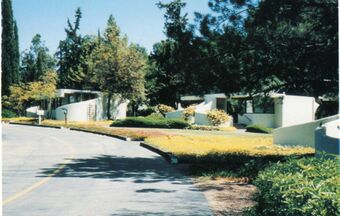 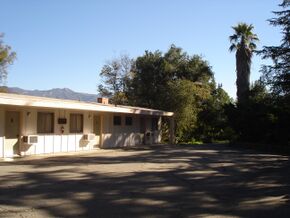
|
Online School of Theosophy
The Online School of Theosophy (OST) is a platform that offers self-paced educational courses built with interactive features and multimedia materials, linking to Theosophy Wiki, YouTube, and other resources. Created as a cooperative effort between the Theosophical Society in America (TSA) and the Krotona Institute of Theosophy, with the generous support of The Kern Foundation, the OST began in 2018 and was launched during the 2019 Summer National Convention. More courses are being added all the time; now there are 25. As of January 2024, there were 2614 registered users from over 80 countries around the world.
Features of Krotona
Krotona Hall provides space for lectures and meetings. The E.S. headquarters building is a house that was donated by Grace Duff Shaw, and houses administrative functions. Visitors seeking books can make purchases from a wide selection at Quest Bookshop.
The Krotona Library was one of the first buildings that went up in 1924. It houses a substantial collections of materials about Theosophy and related subjects for the use of staff and visitors. Lovely gardens provide a serene environment for meditation.
Krotona has also been home to various publishing activities, including Braille materials from the Theosophical Book Association for the Blind.
Additional resources
Websites
Books
- Mills, Joy Mills. 100 Years of Theosophy in America: 1875-1975. Wheaton, IL: Theosophical Publishing House, 1987.
- Ross, Joseph E. Krotona of Old Hollywood, 1866-1913. Krotona series Volume 1. Montecito, Calif.: El Montecito Oaks Press, 1989.
- Ross, Joseph E Krotona of Old Hollywood, 1914-1920. Krotona series Volume 2. Montecito, Calif.: El Montecito Oaks Press, 2004.
- Ross, Joseph E The New Krotona: From Hollywood to Ojai, 1921-1922. Krotona series Volume 3. Montecito, Calif.: El Montecito Oaks Press, 2009.
- Ross, Joseph E Krotona in the Ojai Valley, 1923-1926. Krotona series Volume 4. Ojai, Calif.: Ojai Printing & Publishing Co., 2009.
- Ross, Joseph E Krotona, Theosophy & Krishnamurti, 1927-1931. Krotona series Volume 5. Ojai, Calif.: Ojai Printing & Publishing Co., 2009.
- Vachet, Helene. Taormina's Historic Past and Continuing Story: A Unique Spiritual Community in Ojai. Minneapolis: MCP Books, 2016.
Articles
- Krotona Institute of Theosophy, The in Theosophy World.
- Partners in Theosophy in Theosophy World
- Krotona Institute at Ojai Hub.
- Ojai Pilgrims by Mark Lewis, posted December 19, 2019 at OjaiHub.
Video
- Glimpses of Krotona by Richard A. Chesrow. 1953. This film, originally produced in 16 mm, captures activities at the Krotona School of Theosophy in 1953. Available as DVD.
- The Krotona Experience: Krotona Institute and School of Theosophy by Steve Schweizer. Wheaton, Ill.: Theosophical Society in America, 2012. An overview of the Krotona Institute of Theosophy in Ojai, California.
- Krotona Institute of Theosophy, Ojai, California, October 30, 2019 by Rita Carbon. A visual tour of Krotona with music.
- 'A Theosophical Center in Ojai Since 1924 in Krotona Institute of Theosophy website.
Notes
- ↑ Newspaper clippings from the TSA Archives.
- ↑ Ojai Pilgrims by Mark Lewis, posted December 19, 2019 at OjaiHub.
- ↑ Joseph E. Ross, Krotona in the Ojai Valley, 1923-1926. Krotona series Volume 4. (Ojai, Calif.: Ojai Printing & Publishing Co., 2009), 411.
- ↑ Joseph E. Ross, Krotona in the Ojai Valley, 1923-1926. Krotona series Volume 4. (Ojai, Calif.: Ojai Printing & Publishing Co., 2009), 412-415.
- ↑ Ojai Pilgrims by Mark Lewis, posted December 19, 2019 at OjaiHub.
- ↑ Hein van Beusekom, "Letter from Krotona Institute of Theosophy," The American Theosophist 80.4 (July/August 1992), 8-9.
- ↑ John A. Nimick, "Krotona Institute of Theosophy" The American Theosophist 51 no.17 (December, 1963): 295.
- ↑ Maria Parisen email to Janet Kerschner. March 28, 2024. Theosophical Society in America Archives.
